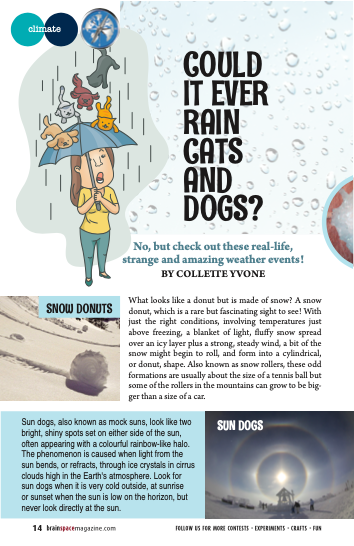
No, but check out these real-life, strange and amazing weather events!
Snow Donuts
What looks like a donut but is made of snow? A snow donut, which is a rare but fascinating sight to see! With just the right conditions, involving temperatures just above freezing, a blanket of light, fluffy snow spread over an icy layer plus a strong, steady wind, a bit of the snow might begin to roll, and form into a cylindrical, or donut, shape. Also known as snow rollers, these odd formations are usually about the size of a tennis ball but some of the rollers in the mountains can grow to be bigger than the size of a car.
Sun Dogs
Sun dogs, also known as mock suns, look like two bright, shiny spots set on either side of the sun, often appearing with a colourful rainbow-like halo. The phenomenon is caused when light from the sun bends, or refracts, through ice crystals in cirrus clouds high in the Earth’s atmosphere. Look for sun dogs when it is very cold outside, at sunrise or sunset when the sun is low on the horizon, but never look directly at the sun.
Raining Fish & Frogs
While it may seem like a scene from a horror movie, there have been numerous eyewitness reports throughout history of frogs, fish, crabs, or other small animals raining down from the sky. What is happening? Scientists explain that during a wind or rainstorm, a tornado or waterspout can form and actually suck up a group of frogs or fish from a body of water such as a lake or pond. The animals are carried away in the wind, and eventually fall back down to the ground. Amazingly enough, sometimes the frogs survive the fall, and simply begin to hop away.
Giant Hailstones
Hailstones form when a strong up-draft of wind carries raindrops high into the atmosphere where they freeze and then fall back to earth as balls, or small pellets, of ice. On rare occasions, during particularly severe thunderstorms, the wind can keep the hailstones aloft for longer periods of time, allowing them to grow quite large: up to the size of an orange, and even bigger. Accord- ing to the National Oceanic and Atmospheric Administration (NOAA), the largest hailstone ever recorded landed in South Dakota, and was over 20.3 cm (8 inches) in diameter. These giant hailstones, sometimes called ice bombs, can damage cars and buildings. When it starts to hail, take cover immediately!
Aurora Borealis
Also known as the Northern Lights, the Aurora Borealis is a spectacular light show caused by the interaction between charged particles emitted from the sun and the Earth’s magnetic field, together with gases in our atmosphere. Winter is the best season to catch the show of pink, green, yellow, red and purple light that waves, flows, flashes and flickers across the night sky of the northern hemisphere.
Ball Lightning
Forks of lightning are a common sight during a thunderstorm, but a rare and unexplained phenomenon can also occur: ball lightning. Scientists are unsure of the cause, whether it be electromagnetic in nature or related to plasma discharges, or even a small explosion of natural gas. Often described as a bright white or blue- white glowing ball of light that seems to float or move through the air, ball lightning is a rare and fleeting sight that only lasts seconds to a few minutes.

